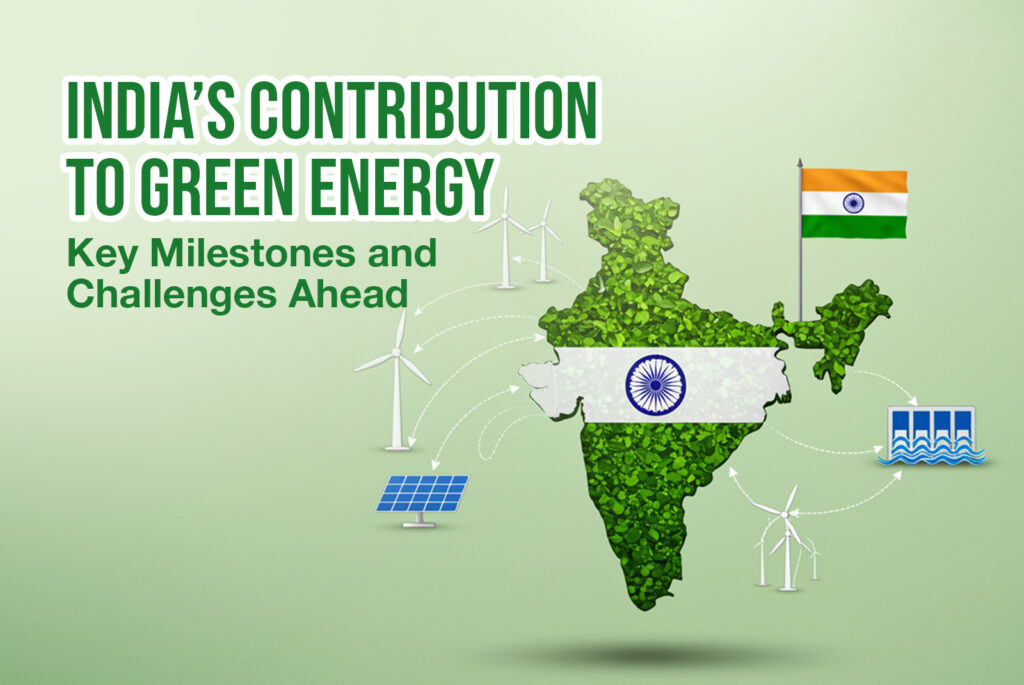India is rapidly emerging as a global leader in green energy, making bold commitments to combat climate change while balancing economic growth. From expanding solar and wind power to pioneering green hydrogen, the country is making significant strides toward a sustainable future. However, the journey is not without hurdles. Financing issues, policy roadblocks, and infrastructure challenges still stand in the way of achieving long-term energy goals.
So, where does India stand today in its green energy transition? What milestones have been achieved, and what challenges lie ahead? Let’s dive in.
India’s Green Energy Revolution: How Far Have We Come?
1. A Renewables Boom: India’s Fastest-Growing Energy Sector
India’s renewable energy sector is growing at an unprecedented rate, with installed capacity surpassing 179 GW as of 2024. The government’s ambitious targets have led to rapid expansion, with solar and wind energy playing a dominant role.
Here’s a quick look at the numbers:
- Solar energy capacity has reached 72 GW, making India one of the top five solar power producers in the world.
- Wind energy capacity has crossed 45 GW, contributing significantly to clean energy generation.
- Hydropower and biomass energy together add another 60+ GW to the renewable mix.
With this growth, India has become the third-largest renewable energy market globally, setting a strong foundation for its future green energy ambitions.
2. India’s Global Climate Commitments: Leading the Charge
At the COP26 Climate Summit in Glasgow (2021), Prime Minister Narendra Modi unveiled India’s Panchamrit strategy, a five-point agenda to combat climate change. The key targets include:
- 500 GW of non-fossil fuel capacity by 2030.
- Meeting 50% of energy needs from renewables by 2030.
- Reducing carbon emissions by 1 billion tonnes by 2030.
- Achieving net-zero emissions by 2070.
These commitments place India in a leadership role on the global stage, influencing international renewable energy policies and collaborations.
3. The Green Hydrogen Mission: A Game-Changer for Energy Transition
One of India’s biggest bets on clean energy is its investment in green hydrogen, an alternative to fossil fuels that can power industries and transportation with zero emissions.
The National Green Hydrogen Mission, launched in 2023, aims to:
- Produce 5 million metric tonnes of green hydrogen annually by 2030.
- Reduce India’s reliance on imported fossil fuels.
- Develop hydrogen-powered industries and vehicles, making clean energy more accessible.
With massive potential in steel, fertilizers, and heavy industries, green hydrogen is set to play a transformative role in India’s energy future.
4. The Electric Vehicle (EV) Push: A Cleaner Future for Transportation
The government’s Faster Adoption and Manufacturing of Hybrid and Electric Vehicles (FAME) scheme has given a major boost to India’s EV sector. In 2023 alone:
- Over 7 lakh electric vehicles were registered, showing a growing shift towards cleaner transportation.
- EV charging infrastructure expanded, with major highways and urban centers installing charging stations powered by renewable energy.
The future of mobility in India is increasingly electric and solar-powered, reducing dependence on fossil fuels and cutting down urban air pollution.
The Roadblocks: Challenges in Scaling India’s Green Energy Goals
Despite these achievements, India’s green energy transition faces several hurdles that must be addressed to sustain long-term growth.
1. High Initial Costs & Investment Gaps
- Large-scale renewable projects require significant capital, and many startups struggle to secure funding.
- While government subsidies exist, private sector investment needs to increase for sustainable growth.
2. Energy Storage & Grid Limitations
- Solar and wind energy are intermittent, making energy storage solutions like batteries crucial.
- India’s power grid needs modernization to handle fluctuating renewable energy supply efficiently.
3. Policy Uncertainty & Bureaucratic Hurdles
- Different policies across states create confusion for businesses and investors.
- Land acquisition for solar and wind farms remains a slow process, delaying project implementation.
The Way Forward: Strengthening India’s Green Energy Future
To overcome these challenges and cement India’s position as a renewable energy powerhouse, the following steps are crucial:
- Boost domestic solar and wind manufacturing under schemes like the Production-Linked Incentive (PLI).
- Expand battery storage solutions for round-the-clock renewable energy availability.
- Accelerate green hydrogen adoption in industrial and transportation sectors.
- Encourage foreign investments and technology transfers to drive innovation.
- Strengthen financial incentives for startups and private players to enter the renewable energy market.
With the right policy push, investment, and technology adoption, India is well on its way to leading the global clean energy revolution. The coming years will be crucial in determining how effectively the country can scale its renewable energy ambitions and contribute to a greener, more sustainable future.

